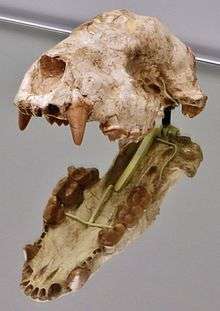Indarctos
Indarctos is an extinct genus of bear, endemic to North America, Europe and Asia during the Miocene. It was present from ~11.1 to 5.3 Ma, existing for approximately 6.2 million years.
| Indarctos | |
|---|---|
 | |
| I. atticus skull | |
| Scientific classification | |
| Kingdom: | Animalia |
| Phylum: | Chordata |
| Class: | Mammalia |
| Order: | Carnivora |
| Family: | Ursidae |
| Subfamily: | Ailuropodinae |
| Tribe: | †Indarctini Abella et al., 2012 |
| Genus: | †Indarctos Pilgrim, 1913 |
| Type species | |
| †Indarctos salmontanus Pilgrim, 1913 | |
| Species | |
|
†I. punjabensis (Lydekker, 1884) | |
The oldest member is from Arizona (~11.1—7.7 Ma) and youngest is (~9.0—5.3 Ma) from Kazakhstan. In North America this animal was contemporary with Plionarctos (~10.3—3.3 Ma).
Fossil distribution
Some sites and specimen ages:
- Box T Site, Lipscomb County, Texas ~9.3—9.2 Ma.
- Rattlesnake site, Grant County, Oregon ~10.3—4.9 Ma.
- Withlacoochee River Site 4A, Marion County, Florida (Indarctos sp.) ~10.3—4.9 Ma.
- Lufeng, Yunnan, China (I. atticus) ~9—5.3 Ma.
- Yulafli (CY), Thrace, Turkey (I. arctoides) ~9.7—8.7 Ma.
- Batallones-3, Madrid Basin, Spain (I. arctoides) ~11.6—5.3 Ma.[3][4]
References
- Qiu, Zhan-Xiang; Tedford, R. H. (2003). "Shānxī bǎo dé yìndù xióngyīxīn zhǒng" 山西保德印度熊一新种 [A New Species of *Indarctos* from Baode, China] (PDF). Vertebrata PalAsiatica. 41 (4): 278–288.
- MacDonald, J. R. (1959). "The Middle Pliocene Mammalian Fauna from Smiths Valley, Nevada". Journal of Paleontology. 33 (5): 872–887. JSTOR 1300922.
- Batallones-3 site
- Abella J, Valenciano A, Pérez-Ramos A, Montoya P, Morales J (2013) On the Socio-Sexual Behaviour of the Extinct Ursid Indarctos arctoides: An Approach Based on Its Baculum Size and Morphology. PLoS ONE 8(9): e73711. doi:10.1371/journal.pone.0073711